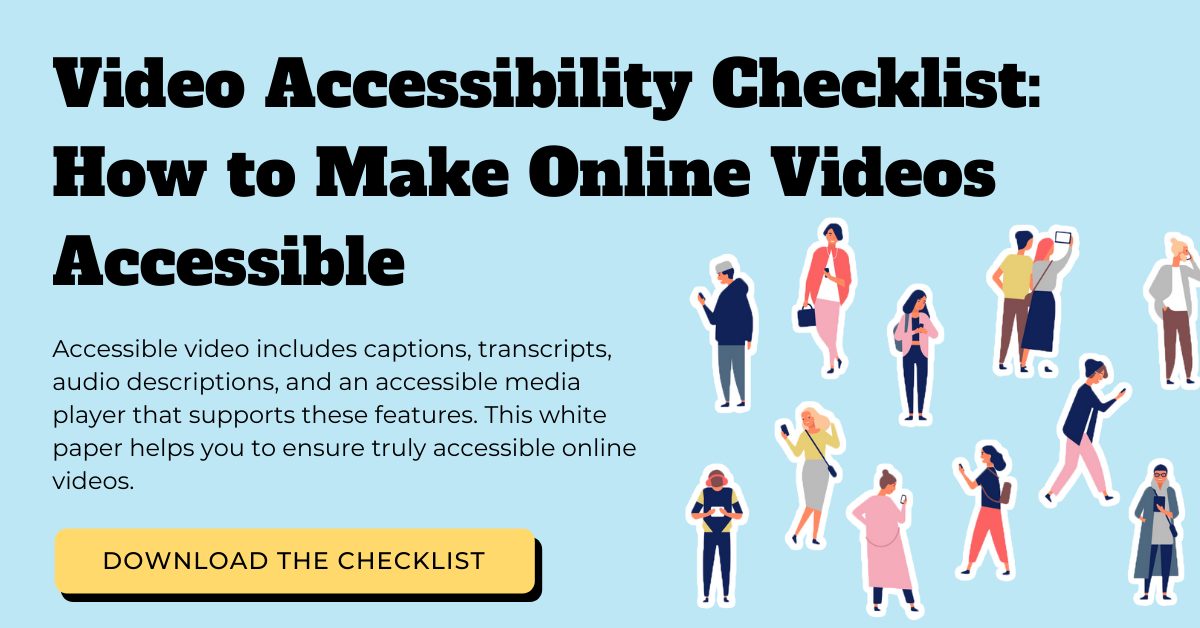5 Reasons to Caption Your Digital Media Publishing Videos
Updated: November 19, 2020
Captioning is the best way to make online videos accessible to people who are deaf and hard of hearing. However, the benefits of captioning digital media publishing videos go far beyond accessibility.
Better user experience, boosted SEO, and greater legal compliance are among some of the reasons why digital media publishers should be captioning their online videos.
Legal Compliance
As public platforms, online media publishing companies may be subject to accessibility laws in the U.S. The Americans with Disabilities Act (ADA), for example, may require captions for digital media publishing videos.
Title III of the ADA requires that places of public accommodation provide equal access to services and communications for people with disabilities. Before the onset of the internet, the ADA was in place to ensure that brick and mortar businesses, like restaurants, movie theaters, and shopping malls, were accessible. However, a string of lawsuits brought against private companies for inaccessible websites, web services, or digital communications, has created a precedent that the ADA applies to internet services, too.
In 2010, the National Association of the Deaf (NAD) filed a suit against Netflix alleging that it was violating the ADA due to the lack of closed captions for all of Netflix’s streaming content. Netflix decided not to go to court and instead to settle with a legally binding consent decree in which it agreed to caption 100% of video content and to continue captioning new content indefinitely.
The outcome of the NAD v. Netflix case was significant because it was the first time the courts interpreted the ADA to apply to online-only businesses. It suggests that the role of the ADA is changing and that even online-only companies and organizations may be subject to captioning requirements under U.S. accessibility law.
Boost SEO
Search engine optimization, a likely familiar term, aims to increase the visibility of websites, pages, and content. Just like written content, search engines rank videos based on criteria like keywords, backlinks, and text both on-page and in the metadata. This is known as video SEO.
It’s no secret that when videos rank higher, people are more likely to watch them. Similar to traditional SEO, video SEO helps increase both views and website traffic from video content.
How do you boost video SEO? Captioning videos is one way to get higher search engine rankings for your digital media publishing videos.
Search engine bots, which scan content for ranking criteria, can’t watch videos, but they can read textual content. Since closed captions come in the form of a text file that the video references as it plays, search engine bots can “watch” the video, i.e., read the text from the caption file. Since bots can better determine content within videos when captions are present, it improves the chance of higher ranks and more visibility.
User Experience
Good user experience is what keeps your audience coming back for more content. In a crowd of literally millions of online videos, how do you help your content to stand out and to stick in your audience’s memory?
Adding captions to your videos is one way to ensure a better user experience.
Facebook found that captions increased video viewership by 12 percent. A research study from the Journal of the Academy of Marketing Science found that captions improve brand recall, verbal memory, and behavioral intent. Another study by the University of Iowa showed that people recalled information better after seeing and hearing it, i.e., captions reinforce visual learning.
The studies are there to back it up – captions encourage more viewership, strengthen recall and comprehension, and improve the overall user experience. As a creator of digital media publishing videos, your goal is to delight your audience with engaging content. With captions in the mix, you can do just that.
Viewing Flexibility
Allowing viewers to watch videos in multiple environments could be vital to getting your message in front of more eyes. That flexibility is made possible by adding captions to videos.
A 2019 study by Verizon Media and Publicis Media found that more people are watching online videos without sound. More specifically, first-party data shows that 92 percent of consumers are watching video on mobile and 83 percent on desktops with the sound off.
This data indicates a new trend of viewing behaviors. Many environments and situations prevent viewers from turning the volume up, such as commuting, being at work, multi-tasking, and more. Due to changes in viewing behaviors, people want captions.
In the same Verizon Media and Publicis Media study, 50 percent of people agreed that captions are essential for watching videos without audio. Eighty percent said they’re more likely to watch an entire video with captions.
Captioned videos are crucial for publishers and help encourage your audience to watch your digital media publishing videos, especially on social media. You can even get creative with your captions and make them look visually appealing to draw more attention to your content and keep viewers hooked.
Reach a Global Audience
Does your organization aim to reach a global audience with your digital media publishing videos? Captions are a great way to increase your global reach.
Captions make it easier to translate videos and create subtitles in different languages. You can offer videos with subtitles in multiple languages, making it more accessible to people all over the world.
The benefit of captions also extends to those who speak English as a second language since English captions help them to follow along with video content more easily.
Digital media publishers should prioritize accessible video content. While equal access is a significant motivator for making videos accessible, the benefits of captions go above and beyond.
Once you experience the benefits of captioning digital media publishing videos, you’ll never go back.









